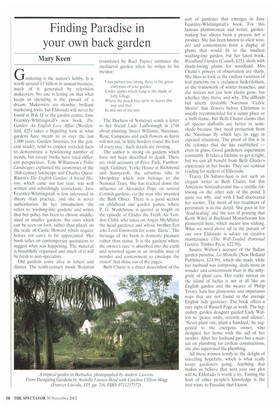Finding Paradise in your own back garden
Mary Keen
Gardening is the nation's hobby. It is worth around £3 billion in annual business, much of it generated by television makeovers. No one is letting on that what keeps us spending is the pursuit of a dream. Makeovers are showbiz, brilliant marketing tools, but Eldorado will never be found at B & 0 or the garden centre. Jane Fearnley-Whittingstall's new book, The Garden: An English Love Affair (Weidenfeld, £25) takes a beguiling look at what gardens have meant to us over the last 1,000 years. Garden histories, for the general reader, tend to employ recycled facts to demonstrate a bewildering number of trends, but recent books have tried different perspectives. Tom Williamson's Polite Landscapes explained the economics of the 18th-century landscape and Charles QuestRitson's The English Garden: A Social Histoty, which came out last year, was well written and refreshingly iconoclastic. Jane Fearnley-Whittingstall is less interested in theory than practice, and she is never authoritarian. In her introduction she refers to 'washing-line gardens' and writes that her policy has been to choose middlesized or smaller gardens, the ones which can be seen on foot, rather than places on the scale of Castle Howard which require horses (or cars) to be appreciated. Her book relies on contemporary quotations to suggest what was happening. The material is beautifully organised and much of it will be fresh to non-specialists.
Old gardens come alive in letters and diaries. The tenth-century monk Walafrid (translated by Raef Payne) animates the mediaeval garden when he writes to his mentor:
I can picture you sitting there in the green enclosure of your garden Under apples which hang in the shade of lofty foliage Where the peach tree turns its leaves this way and that In and out of the sun.
The Duchess of Somerset sends a letter to her friend Lady Luxborough in 1748 about planting 'Sweet Williams, Narcissus, Rose, Campions and such flowers as hares will not eat, in little borders round the foot of every tree'. Such details are riveting.
The author is strong on gardens which have not been described to death. There are vivid accounts of Prior Park, Farnborough, Goldney, Yorke House at Richmond and Sunnycroft, the suburban villa in Shropshire which now belongs to the National Trust. She has tracked down the influence of Alexander Pope on several Cornish gardens, via the man who invented the Bath Oliver. There is a good section on childhood and garden games, where P. G. Wodehouse is quoted at length on the episode of Gladys the Fresh Air London Child, who takes on Angus McAllister the head gardener and whose brother Ern asks Lord Emsworth for some 'flarze'. The message of the book is domestic pleasure rather than status. It is the gardens where the owner's care is absorbed into the earth and returned again in an invisible mist of wonder and contentment to envelope the visitor' that shine out of the pages.
Beth Chatto is a direct descendant of the sort of gardener that emerges in Jane Fearnley-Whittingstall's book. For this famous plantswoman and writer, gardenmaking has always been a process not a product. She has been known to elicit wonder and contentment from a display of plants that would fit in the smallest washing-line garden, but her latest book. Woodland Garden (Cassell, £25), deals with shade-loving plants for woodland. Mrs Chatto's powers of observation are sharp. She likes to look at the endless variation of leaf patterns on a cyclamen heclerifolium, or the framework of winter branches, and she notices not just how plants grow, but whether they thrive and why. The difficult but utterly desirable Narcissus 'Cedric Morris' that flowers before Christmas is usually recommended for a sunny place or a bulb frame, but Beth Chatto claims that all species daffodils are better in semishade because they need protection from the Narcissus fly which lays its eggs in exposed situations. The proof of this is in the colonies that she has established — even in grass. Good gardeners experiment constantly. It takes a lifetime to get it right, but we can all benefit from Beth Chatto's experience in her books. They are seminal reading for seekers of Eldorado.
Tracey Di Sabato-Aust is not such an elegant writer as Beth Chalk), but this American horticulturalist has a terrific following on the other side of the pond. I quite see why, and wish I had discovered her sooner. The merit of her treatment of perennials is in the detail. She goes in for 'dead-leafing' and the sort of pruning that Keith Wiley at Buckland Monachorum has pioneered here, which means less staking. What we need above all in the pursuit of our own Eldorado is advice on creative maintenance (The Well-Tended Perennial Garden, Timber Press, £22.50).
Susana Walton's account of the Italian garden paradise, La Mortella (New Holland Publishers, £24.99), which she made while her husband was composing, deals more in wonder and contentment than in the nittygritty of plant care. Her rocky retreat on the island of Ischia is not at all like an English garden and the wearer of Philip Treacy hats has glamorous and impetuous ways that are not found in the average English lady gardener. The book offers a rare sight of Russell Page at work. The legendary garden designer guided Lady Walton to 'peace, unity, serenity and silence'. 'Never plant one, plant a hundred,' he suggested to the energetic owner, who designed her home with the aid of her mother. After her husband gave her a manual on plumbing for civilian constructions, she also supervised the plumbing.
All these women testify to the delight of travelling hopefully, which is what really keeps gardeners going. Anything that makes us believe that next year our plot will be Eldorado is worth a try. Tasting the fruit of other people's knowledge is the best route to Paradise that I know.


























































































 Previous page
Previous page